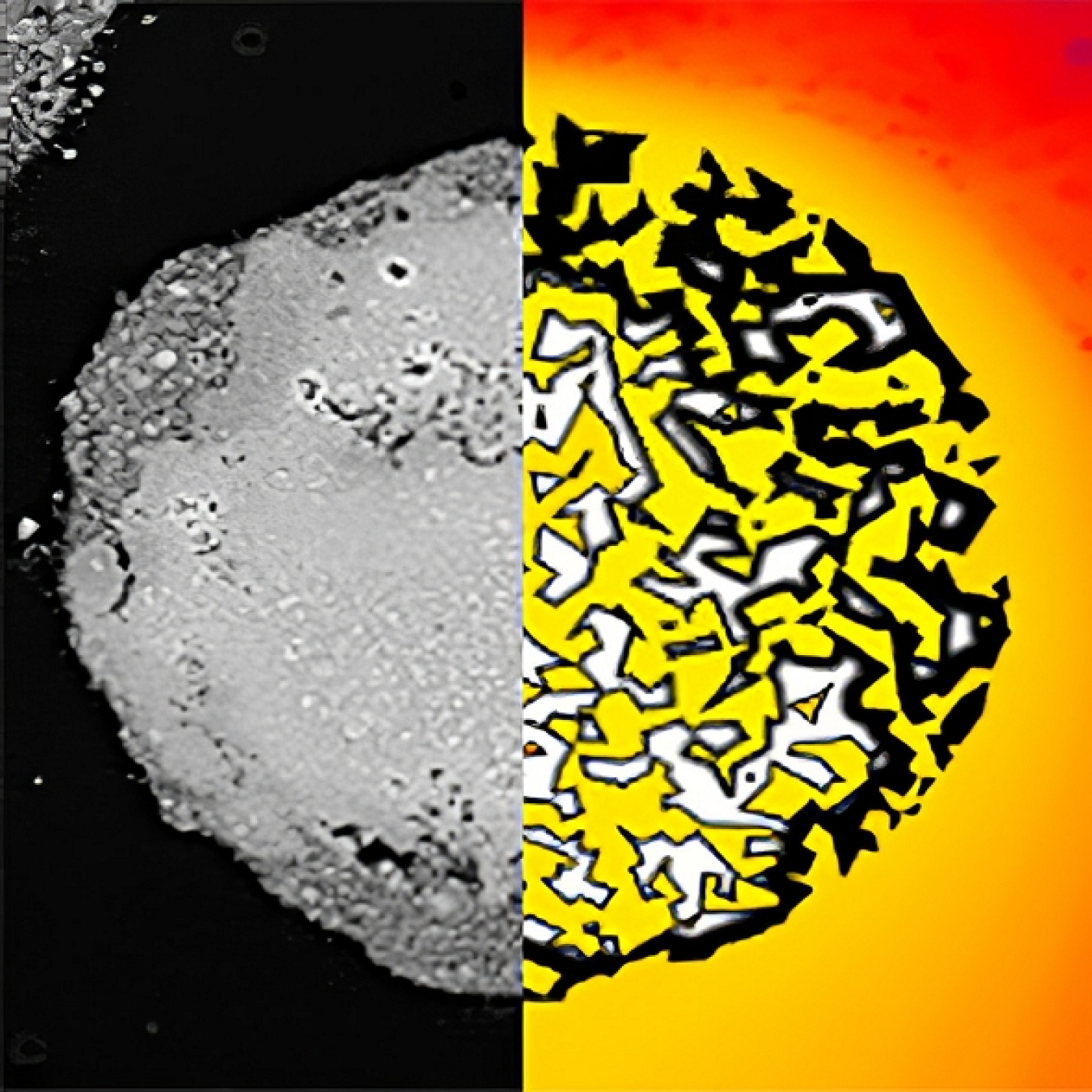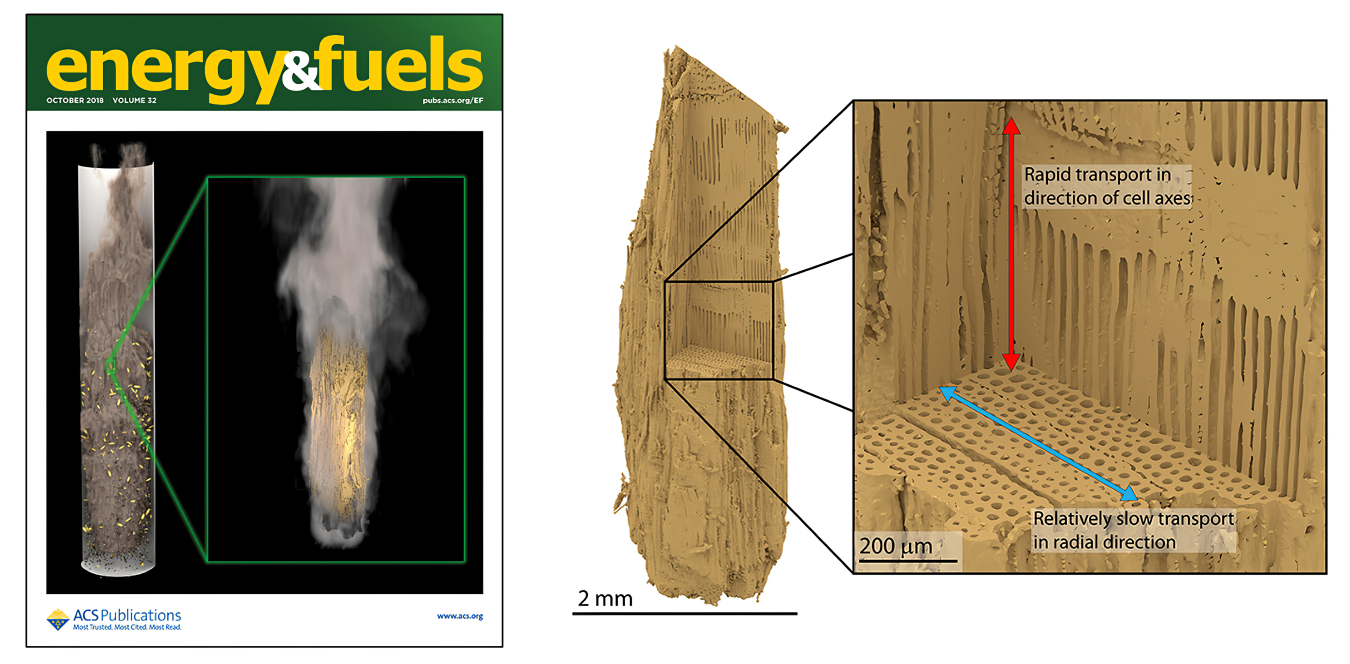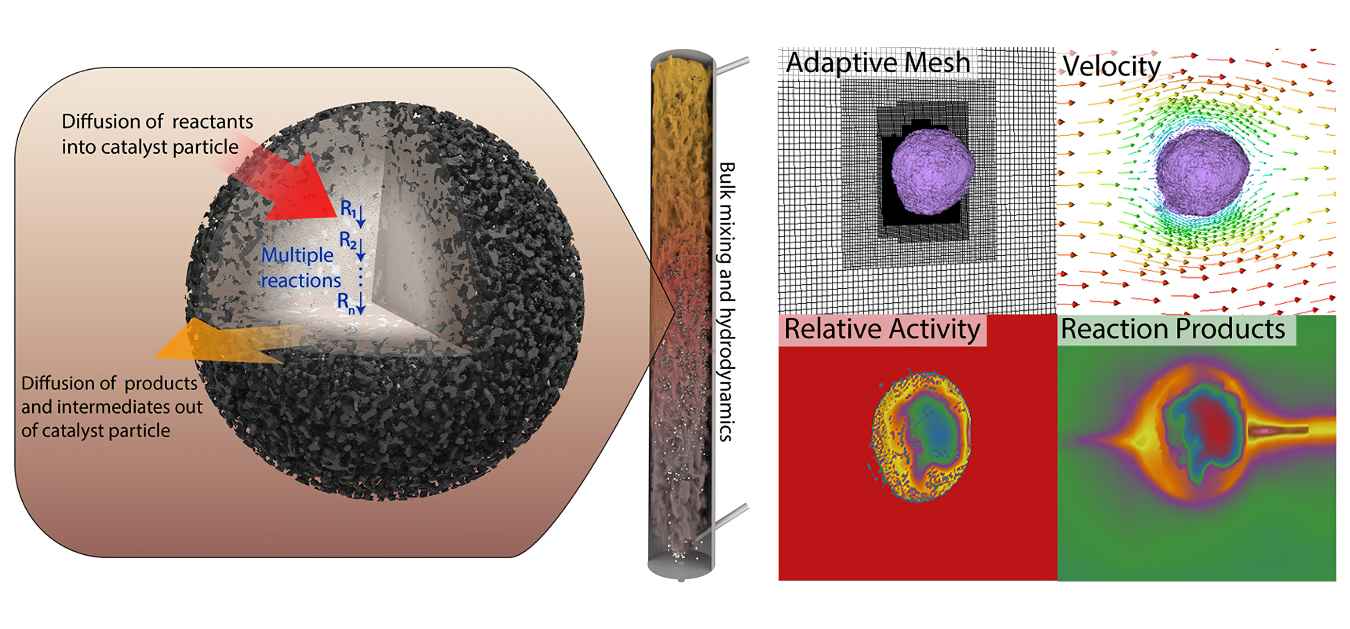The Consortium for Computational Physics and Chemistry (CCPC) studies the rapid molecular transformations that occur at the atomic scale as well as the bulk mixing and transport of reactants, products, and catalysts that occurs at the reactor scale. In between these two scales lies an intermediate regime called the “mesoscale.” Many important processes occur at the mesoscale, including:

An image of a catalyst particle. The left half shows a scanning electron micrograph of the catalyst. The right half shows a model simulation of the catalyst with porosity and coke buildup. Image courtesy of Kinga Unocic, Oak Ridge National Laboratory (left half) and Peter Ciesielski, National Renewable Energy Laboratory (right half).
- Heat transfer from the reactor environment to the interior of feedstock and catalyst particles
- Transport of reactants and products into and out of catalyst particles
- Boundary layer effects, which mediate transport between bulk fluid and particles in the reactor
These processes are intimately coupled to reaction rates and bulk transport effects. They are also strongly influenced by micro-scale feedstock properties and catalyst properties such as intra-particle porosity, shape, size, and density. In fact, accurate predictions of overall process performance cannot be made unless these mesoscale factors are accounted for.
Thermochemical Conversion of Biomass Particles
Biomass feedstocks are inherently variable. Variations can manifest as differences in:
- Density
- Porosity
- Composition
- Particle size distribution
- Shape distribution
The source of this variability can come from the species of origin (e.g., pine wood vs. switch grass) and/or processing conditions (milling, heating, washing, etc.). These characteristics are often too detailed to handle explicitly at the bulk scale, and too large to manifest at the atomic scale.
The CCPC has developed advanced mesoscale models that account for all these relevant feedstock attributes. Using various imaging techniques, the microstructure of various feedstocks is incorporated into models of biomass particles. Other experimental measurements, such as composition and mechanical characterizations, are used to further specify the behavior of the particles.
Since feedstocks always exhibit a distribution of particle characteristics, the CCPC runs many particle simulations that span the range of the property distributions. These results are summarized in a concise mathematical format that enables them to directly inform reactor-scale simulations of the impact of feedstock variations.

Left: Depiction of coupled particle-scale and reactor-scale simulations for fast pyrolysis of biomass, adapted from Pecha et al. and featured on the cover of ACS Energy & Fuels.
Right: X-ray computed tomography reconstruction of a biomass particle, revealing highly directional porosity, which dictates intra-particle transport phenomena. Adapted from Ciesielski et al.
Conversion in Catalyst Particles
Industrial reactor systems must be precisely tuned to effectively move reactants and products through the reactor, coordinate efficient interactions between reactants and catalyst active sites so that the intended chemistry can occur, and mitigate deactivation and undesirable side reactions as much as possible. Mesoscale catalyst characteristics, such as particle size, shape, and porosity, are tunable features that provide means to control what happens in micro environments within catalyst particles in the reactor.
For example, the porosity and active site density in catalyst particles impact the effective reaction rate, which can be used to determine optimal flow rates throughout the reactor. Many reactor systems require periodic, or even continual, regeneration of the catalyst, and the optimal rate at which regeneration is performed is also strongly influenced by mesoscale factors.
CCPC: Understanding How Mesoscale Catalyst Features Impact Performance
The CCPC uses detailed catalyst particle models to predict how overall process performance is impacted by mesoscale catalyst features. These simulations are useful to help design catalyst architectures that deliver optimal transport throughout the particle interior and can also identify reactor operating conditions that optimize system performance for a given catalyst.
The simulation framework models reacting flows in and around porous geometries using computational fluid dynamics methods. The CCPC also uses adaptive mesh refinement to enable high-resolution predictions of physical and chemical processes in complex, dynamic system geometries.

Left: Depiction of diffusion limited, cascading reactions occurring within a catalyst particle in a fluidized bed reactor; adapted from Lattanzi et al. Right: Visualization of a catalyst particle simulation utilizing adaptive mesh refinement and explicit catalyst geometry obtained from 3D X-ray imaging. Images courtesy of Hari Sitaraman, National Renewable Energy Laboratory.
